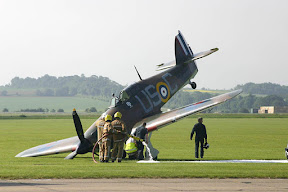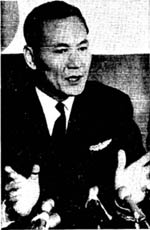 A few days ago, I went up for some tailwheel landings and was really happy with my progress. I couldn't wait to go up the next day and do some more landings to see if I could solidify the muscle memory. So, yesterday, I did go do some more tailwheel landings and boy did it ever suck!
A few days ago, I went up for some tailwheel landings and was really happy with my progress. I couldn't wait to go up the next day and do some more landings to see if I could solidify the muscle memory. So, yesterday, I did go do some more tailwheel landings and boy did it ever suck!I bounced it around pretty good the first few attempts and got so flustered that I couldn't even read my altimeter (let alone hold pattern altitude). It may have been the worst flying I've ever done.
Now, I know that everybody has bad days, but for the life of me I couldn't figure out how it ended up that bad. Well, the fact is that flying a tailwheel airplane is tough to do. Some very good pilots have been groundlooped by a gusty wind. Everybody goes through this with conventional gear.
I also think I'm at a disadvantage because of my tricycle gear experience. Thing is, at this point, a 20 to 30 knot gusting and variable crosswind doesn't really phase me. In fact, it doesn't even make my palms sweat anymore.
So, when I showed up at my tailwheel school, my instructor asked, "are you sure you want to go? 22 knots is pretty fast." Of course, I thought, "yeah, 22 knots mostly down the runway is no big deal! Let's go."
Well, several really tough approaches and landings later, I gave up for the day. Sitting in the flight school, the owner of the plane said, "I can't believe you tried today. I usually don't fly with wind above 4 or 5 knots." My instructor said when he bought his first taildragger, he wouldn't go above 7 or 10 knots. It helped to know that 22 knots is a lot of wind in a taildragger.
So, I have two tips for the conventional gear hopeful. First, don't get discouraged! Flying a taildragger is really hard. Second, a little wind changes things a lot in a taildragger. It is good to get the high wind experience, but count on some rough times and remember how much time you had to get in your tricycle gear trainer before you were comfortable with a heavy crosswind.
Have fun. Be safe. Happy Piloting.
I really appreciate comments so please feel free to comment on my posts. Whether you agree or disagree, I'd love to hear from you. Also, feel free to link back to your own blog in your comments. You can even subscribe to an RSS feed of the comments on this thread.
© 2008 — , D. Patrick Caldwell, Vice President for Research and Development, Emerald Software Group, LLC
© 2008 — , D. Patrick Caldwell, Vice President for Research and Development, Emerald Software Group, LLC


 A few friends of mine and I decided to fly around and watch fireworks from the sky. It was a lot more fun than sitting there in a dirty parking lot watching it. Then we flew around looking for Lake Lanier but couldn't find it. Not because of the drought, but because all of boats with their lights on looked like cars.
A few friends of mine and I decided to fly around and watch fireworks from the sky. It was a lot more fun than sitting there in a dirty parking lot watching it. Then we flew around looking for Lake Lanier but couldn't find it. Not because of the drought, but because all of boats with their lights on looked like cars. I've flown with about 6 or 7 different flight schools since I started flying. They all have their ups and downs. Some have the best instructors, others have the best prices.
I've flown with about 6 or 7 different flight schools since I started flying. They all have their ups and downs. Some have the best instructors, others have the best prices.  When you start working on earning your private ticket, you're under the fortunate circumstance that you don't know anything. You're a clean slate. Every time you go fly, you learn something new and exciting while you build your piloting skills.
When you start working on earning your private ticket, you're under the fortunate circumstance that you don't know anything. You're a clean slate. Every time you go fly, you learn something new and exciting while you build your piloting skills.  Most pilots understand why air density decreases with increases in temperature; however, a lot of us have a problem wrapping our brains around why increases in humidity yield decreases in air density.
Most pilots understand why air density decreases with increases in temperature; however, a lot of us have a problem wrapping our brains around why increases in humidity yield decreases in air density. When I was in graduate school, I read a chapter from a book named The Abilene Paradox. The chapter that was chosen for my management course was called, "Captain Asoh and the Concept of Grace." The chapter is about the November 22nd, 1968
When I was in graduate school, I read a chapter from a book named The Abilene Paradox. The chapter that was chosen for my management course was called, "Captain Asoh and the Concept of Grace." The chapter is about the November 22nd, 1968  click for more information
click for more information
